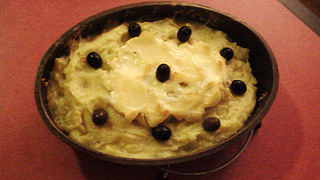Knödel or Klöße are boiled dumplings commonly found in Central European and East European cuisine. Countries in which their variant of Knödel is popular include Austria, Bosnia, Croatia, Czechia, Germany, Hungary, Poland, Romania, Serbia, Slovakia and Slovenia. They are also found in Scandinavian, Romanian, northeastern Italian cuisine, Ukrainian, Belarusian and French (Alsatian) cuisines. Usually made from flour, bread or potatoes, they are often served as a side dish, but can also be a dessert such as plum dumplings, or even meat balls in soup. Many varieties and variations exist.

Bacalhau is the Portuguese word for cod and—in a culinary context—dried and salted cod. Fresh (unsalted) cod is referred to as bacalhau fresco.

João Vaz Corte-Real was a Portuguese sailor, claimed by some accounts to have been an explorer of a land called Terra Nova do Bacalhau, speculated to possibly have been a part of North America. These accounts assert that Corte-Real was awarded the donatário–captaincies of São Jorge and Angra for his accomplishments, but contemporary documents contradict this claim.

The Cobb salad is an American garden salad typically made with chopped salad greens, tomato, bacon, chicken breast, hard-boiled eggs, avocado, chives, blue cheese and red wine vinaigrette. The ingredients are laid out on a plate in neat rows. It is served as a main course.

Papri chat or papri chaat is a popular traditional fast food and street food from the Indian subcontinent, in India, Bangladesh, Nepal and parts of Pakistan. Many various additional dishes throughout India are also referred to as papri chat. Some restaurants in the United States serve the traditional version of the dish.

Fresh fish rapidly deteriorates unless some way can be found to preserve it. Drying is a method of food preservation that works by removing water from the food, which inhibits the growth of microorganisms. Open air drying using sun and wind has been practiced since ancient times to preserve food. Water is usually removed by evaporation but, in the case of freeze-drying, food is first frozen and then the water is removed by sublimation. Bacteria, yeasts and molds need the water in the food to grow, and drying effectively prevents them from surviving in the food.

Bolinhos de bacalhau ( or pastéis de bacalhau (, in Central and Southern Portugal and in Portuguese-speaking African countries are typically made from a mixture of potatoes, bacalhau, eggs, parsley, onion and sometimes a hint of nutmeg. They are also commonly referred to as "salt cod fritters" or "salt cod croquettes". The bolinhos or pastéis de bacalhau are shaped using two spoons, deep fried and served hot or cold before meals as an appetizer or as a meal itself. Ideally, they should be slightly crunchy on the outside and soft and creamy on the inside.

A fishcake is a culinary dish consisting of filleted fish or other seafood minced or ground, mixed with a starchy ingredient, and fried until golden.

Dried and salted cod, sometimes referred to as salt cod or saltfish or salt dolly, is cod which has been preserved by drying after salting. Cod which has been dried without the addition of salt is stockfish. Salt cod was long a major export of the North Atlantic region, and has become an ingredient of many cuisines around the Atlantic and in the Mediterranean.
Pastel is the Spanish and Portuguese word for pastry, a sugary food, and is the name given to different typical dishes of various countries where those languages are spoken. In Mexico, pastel typically means cake, as with Pastel de tres leches. However, in different Latin American countries pastel can refer to very different sugary dishes, and even to non-sugary ones as well. In some places, like Brazil, a pastel can refer to both a sugary and non-sugary food, depending on the filling used.
Bermudian cuisine reflects a rich and diverse history and heritage blending British and Portuguese cuisine with preparations of local seafood species, particularly wahoo and rockfish. Traditional dishes include codfish and potatoes served either with an add on of hard boiled egg and butter or olive oil sauce with a banana or in the Portuguese style with tomato-onion sauce, peas and rice. Hoppin' John, pawpaw casserole and fish chowder are also specialties of Bermuda. As most ingredients used in Bermuda's cuisine are imported, local dishes are offered with a global blend, with fish as the major ingredient, in any food eaten at any time.

The bocadillo or bocata, in Spain, is a sandwich made with Spanish bread, usually a baguette or similar type of bread, cut lengthwise. Traditionally seen as a humble food, its low cost has allowed it to evolve over time into an iconic piece of cuisine. In Spain, they are often eaten in cafes and tapas bars.

A bacalaíto is a salted codfish fritter, a traditional Puerto Rican snack that typically is eaten with an entire meal. Bacalaítos are served at the beach, cuchifritos, and at festivals. They are crispy on the outside and dense and chewy in the inside.

Bacalhau à Zé do Pipo is a common codfish (bacalhau) dish in Portugal. It is an oven baked dish, consisting in layers of bacalhau, onion, mashed potatoes with a hint of ground nutmeg, and mayonnaise. Although mayonnaise is not traditionally used in Portuguese cuisine, in this dish it's considered typical. It is usually garnished with olives and/or peppers. The recipe originates from Porto, having achieved popularity in Vizela, being named after its creator, Zé do Pipo, who owned a famous restaurant in that city during the 1960s. He won a national gastronomic contest with this main course, making many restaurants adopt it in their menus and popularizing it through the country to this day.

A coulibiac is a type of pirog usually filled with salmon or sturgeon, rice or buckwheat, hard-boiled eggs, mushrooms, onions, and dill. The pie is baked in a pastry shell, usually of brioche or puff pastry.

Garlic soup is a type of soup using garlic as a main ingredient. In Spanish cuisine, sopa de ajo is a traditional garlic soup made with bread and egg poached in chicken broth, and laced with garlic and sherry.

Chahan, also known as Yakimeshi, is a Japanese fried rice dish prepared with rice as a primary ingredient and myriad additional ingredients and seasonings. The dish is typically fried, and can be cooked in a wok. Chahan may have originated in the 1860s from Chinese immigrants arriving at the port of Kobe. Chahan is a staple food in homes in Japan. Some restaurants outside Japan serve the dish as a part of their fare.

Raisin cake is a type of cake that is prepared using raisins as a main ingredient. Additional ingredients are sometimes used, such as chocolate and rum. Raisin cake dates back to at least the time of the reign of David, circa 1010–970 BCE. Boiled raisin cake is prepared by boiling various ingredients and then baking the mix in an oven. It dates back to at least the time of the American Civil War (1861–1865).

Buljol is a salad dish of the cuisine of Trinidad and Tobago. It consists of chopped salted cod, tomatoes and chilies. The name is of French origin. 18th-century colonial power Spain launched the cédula de población in 1783, an edict that successfully promoted the settling of French planters in Trinidad who quickly set the population majority. The name is a combination of the French words brulé ('burnt') and gueule ('muzzle'), which was changed into bu'n jaw in Trinidad's 19th century patois and finally morphed into buljol. The name does not relate to the temperature of the dish but to its spiciness, caused by the added hot pepper.















